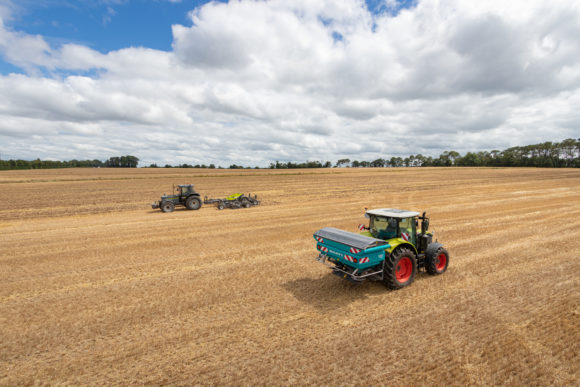Silver medal for the new spreading homogeneity technology!
A word from the jury: “The precision of solid fertiliser distribution by centrifugal technique has made great strides in the last ten years, particularly through synergies between manufacturers and research institutes in controlled environments. The proposed solution makes it possible to maintain this precision at increasingly high working speeds and thus reduce the use and environmental impact of synthetic fertilisers.”
The speed of travel is increasingly important in the execution of field work
Semi-auto, auto or continuously variable gearboxes allow easy and optimal adaptation of the operating speed. This means that mounted and towed implements must be upgraded to absorb these high speed variations. Fast seeding with TCS or single-seed drills is now possible at speeds of up to 20km/h. Mowing grass at 25Km/h is quite common today. Fertiliser spreading is no exception to this trend and, on the contrary, when the soil is strong and well levelled (3rd or 4th application of wheat), speeds of up to 25-30km/h are possible.
The SPEED CONTROL
Centrifugal spreaders apply fertiliser to the ground in a semi-annular pattern. This pattern is most often measured using CEMIB type test rigs. The effect of the speed of movement of the fertiliser spreader is not taken into account in these measurements. However, the speed of movement influences the slick produced on the ground by deforming it in particular in the direction of movement of the distributor.
SULKY has therefore observed during work carried out with INRAE and AgroSup Dijon that the quality of fertilizer distribution in the field varies with the speed of travel. Based on this observation and following a patented concept, SULKY has developed a technology for adapting the spreading table to the speed of travel: SPEED CONTROL
The state of the market, differentiating points and advantages for the user
Nowadays, a large proportion of fertiliser spreading is done by centrifugal spreading. The evaluation of the accuracy of this technique has never included a variation in tractor speed. However, practice shows that speed variation in the field is common, for example for the following reasons:

This technology, which manages the impact of speed on the homogeneity of the spread pattern, was previously non-existent on the market. From now on, this technology is available to the greatest number of people on the X40+ ECONOV – SPEED CONTROL & X50+ ECONOV – SPEED CONTROL distributors Accessibility to technology for all, precision and cost reduction With SPEED CONTROL, Sulky democratises the angular correction technology and accompanies farmers in an approach that meets environmental and agronomic criteria.
Agriculture contributes to climate change but is also affected by it. The EU must reduce its greenhouse gas emissions from agriculture and adapt its production system by reducing the doses of synthetic fertiliser applied through improved efficiency of nitrogen inputs. On the other hand, the European Commission recommends, by 2030, a reduction of 20% in the consumption of mineral nitrogen fertilisers on a European scale.
SPEED CONTROL provides solutions that can address this dilemma. And through this technology, a better distribution of fertilizers, respect for the environment and a better efficiency in the assimilation of nitrogen by the plant is now possible (reduction of the risks of lodging). As a reminder, SULKY already has the patented ECONOV technology that allows to save up to 15% of fertilizer per hectare and the SPEED CONTROL is integrated to it.


